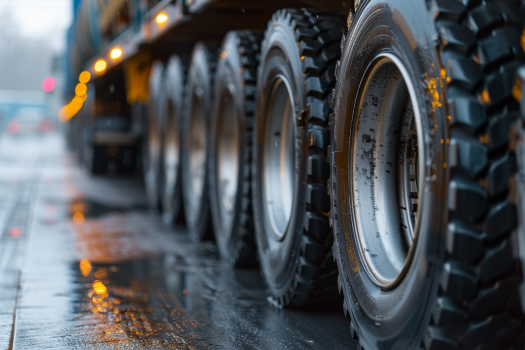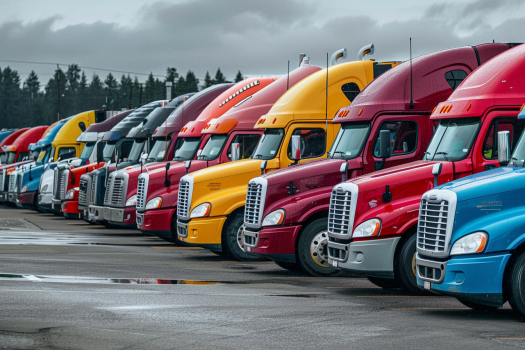Last Updated on August 28, 2024
Examining Market Trends and Material Costs Fueling the Rise in Truck Tire Prices
In recent years, the trucking industry has observed a notable upward trend in the cost of tires, an essential component for the safety and efficiency of truck operations. This introduction explores the causes of the growing price of truck tires by thoroughly analyzing the market patterns and variables affecting these price fluctuations. Tire prices have been rising noticeably, which has a significant influence on trucking business operating costs.
The escalation in truck tire costs is multifaceted, impacting aspects such as the cost of raw materials, technological developments, global economic patterns, and regulatory modifications. Fleet operators and other industry players must comprehend these dynamics. This introduction aims to unravel the intricate web of elements driving this inflation, providing insights into the changing landscape of the truck tire market.

Overview of Truck Tire Market Trends
Due to several international and sector-specific reasons, the truck tire market has experienced notable price swings. Price stability was initially a defining market feature since manufacturer rivalry controlled costs. Recent patterns, though, seem to be changing. The following are essential elements influencing this shift:
- Costs of Raw Materials: Several international economic reasons have caused volatility in the price of rubber, both synthetic and natural, which is a crucial component used in tire manufacturing.
- Technological Advancements: Tire manufacturers have introduced innovations that have raised production costs to improve safety and efficiency.
- Impact of Regulations: Increasingly stringent safety and environmental laws have required changes to industrial procedures, which has raised costs.
- Influences of the global economy: Fluctuating exchange rates, tariffs, and oil prices greatly influence the cost of truck tires.
- Demand and Supply Dynamics: E-commerce’s impact on logistics and the increased demand for specialty truck tires have substantially impacted market dynamics.
The Raw Material Price Surge
In the intricate ecosystem of truck tire manufacturing, the surge in raw material costs has significantly contributed to rising tire prices. This section of the article delves into the factors driving these increases, focusing on the impact of global rubber market fluctuations, the role of synthetic materials, and the transportation and logistics costs associated with these raw materials.
Impact of Global Rubber Market Fluctuations
Tire production relies heavily on rubber, both synthetic and natural. Natural rubber prices are incredibly erratic since the whims of the world market determine them. Weather patterns in major rubber-producing nations like Thailand and Indonesia can significantly impact supply and drive up prices. Global economic conditions, trade policies, and geopolitical developments significantly influence market dynamics. Trade disputes between significant economies can affect the price of rubber and, consequently, the cost of manufacturing truck tires, resulting in tariffs and trade barriers.
The Role of Synthetic Materials in Cost Increases
Synthetic materials used to enhance tire performance and longevity have also increased in price. These materials are sensitive to oil price changes because they are derived from petrochemicals. The price of synthetic rubber and other petroleum-based tire components fluctuates in tandem with the state of the world oil market. Furthermore, the cost is further driven by the growing demand for more sophisticated and environmentally friendly materials that have reduced carbon footprints and improved fuel efficiency. Tire prices have increased because these new materials frequently require more intricate production procedures and premium raw ingredients.
Transportation and Logistics Costs for Raw Materials
Another important consideration is the price of processing and shipping these raw resources. The tire production logistics network sources its raw materials from many regions worldwide. Raw material costs can be significantly impacted by changes in fuel prices, variations in transportation costs, and logistical difficulties like those encountered during the COVID-19 epidemic. Regulations about shipping and transportation intended to lessen their adverse environmental effects may also raise tire manufacturers’ operating expenses, which they then pass to customers through higher tire pricing.
Technological Advancements in Tire Manufacturing
The truck tire industry has undergone significant technological transformations in recent years. While beneficial in enhancing tire performance and sustainability, these advancements have also contributed to rising production costs. This segment explores the various innovations in tire manufacturing, the shift towards eco-friendly and durable tires, and the challenge of balancing performance with cost.
Innovations Leading to Higher Production Costs
T tire manufacturing uses advanced technologies that improve safety, longevity, and fuel efficiency. Some of these advances include new rubber compositions, strengthened sidewalls for better weight handling, and better tread designs. On the other hand, these technologies are not accessible for development and use. Tire manufacturers invest significant money in research and development (R&D) to create new materials and design techniques. Modern manufacturing techniques and equipment must be used to make these sophisticated tires, increasing production costs. The ultimate cost of the tires is directly impacted by this technological investment, which is necessary to meet the ever-increasing expectations for performance and safety.
The Shift to Eco-Friendly and Durable Tires
The global movement towards sustainability has had an impact on the tire sector as well. Demand for environmentally friendly tires constructed of sustainable materials with a lower environmental impact is rising. These green tires frequently use recyclable materials, natural rubber alternatives, and creative designs to reduce rolling resistance and increase fuel efficiency. Durable tires with longer lifespans are also gaining popularity because they are expected to be more economical. However, more resources are needed to develop, manufacture, research, and develop these long-lasting and environmentally friendly tires, which raises production prices.
Balancing Performance with Cost
One of tire producers’ most significant difficulties is balancing tires’ increased performance and sustainability with the requirement to keep them reasonably priced. High-quality, eco-friendly, and performance-focused tires are in high demand, yet these criteria frequently drive up production costs. Tire manufacturers often look for methods to reduce costs by streamlining their manufacturing procedures and better using their materials. This balancing act is essential in a market where price competitiveness is still critical.
The ongoing technological advancements in tire manufacturing signify a remarkable evolution in the quality and capabilities of truck tires. However, these improvements come with increased costs due to higher production expenses, the shift towards eco-friendly materials, and the need to balance performance with affordability. Understanding these factors is essential for companies and consumers in the trucking industry to navigate the changing landscape and make informed decisions about tire purchases.
Economic Factors and Market Dynamics
The pricing of truck tires is not only a matter of production and technology but is also profoundly influenced by broader economic factors and market dynamics. This section explores the influence of global financial conditions, the impact of supply chain disruptions, and the role of tariffs and trade policies on truck tire pricing.
The Influence of Global Economic Conditions
The state of the world economy significantly shapes the truck tire market. Economic growth or recession in critical markets directly impacts truck tires and commercial vehicle demand. There is usually a spike in manufacturing and transportation activity during economic expansions, which raises the need for truck tires. On the other hand, demand frequently decreases during economic downturns. Tire costs are also impacted by interest, inflation, and currency exchange rates, which can affect the cost of raw materials and manufacturing processes. For example, a stronger dollar could increase the cost of raw material imports for American tire makers, raising the price of tire production.
Supply Chain Disruptions and Their Impact
Disruptions in the supply chain can significantly affect tire pricing and production. Natural disasters, geopolitical unrest, or pandemics like COVID-19 may disrupt the supply of raw materials or stop production, resulting in shortages and price rises. The truck tire business is especially vulnerable to these disruptions because it heavily depends on an international supply chain. During the COVID-19 epidemic, for instance, trade and movement restrictions significantly impacted the supply of raw materials and components, which delayed manufacturing and raised costs.
Understanding the Role of Tariffs and Trade Policies
Trade agreements and tariffs significantly impact truck tire prices. Tariffs on imports of raw materials may raise tire producers’ production costs, which they may then pass along to customers. Trade conflicts and shifting trade agreements can also cause market volatility and uncertainty. In a trade dispute, tariffs on imported tires or raw materials, for instance, may raise costs. Furthermore, national regulations on environmental standards and tire safety may impact market prices and production costs.
Essential factors in the truck tire sector include the state of the economy and market dynamics. Manufacturers, suppliers, and customers must be aware of these aspects to successfully negotiate the market’s complexity. The relationships among trade policies, supply chain stability, and global economic conditions substantially impact truck tire pricing and availability, shaping consumer and company choices and business plans.
Demand Patterns in the Trucking Industry
Comprehending the trucking industry’s demand patterns is essential to understanding the dynamics of truck tire costs. This section covers important topics such as the need for specialty truck tires, the effects of fleet growth and replacement cycles, and how the advent of e-commerce affects the need for truck tires.
Analyzing the Demand for Specialized Truck Tires
Truckers operating in long-haul, regional, urban, and off-road segments have noticed increased demand for specialty tires from the trucking business. For optimum performance, tires in each category must have particular attributes. While urban tires are meant for frequent stopping and starting, long-haul tires are made for fuel efficiency and durability over long distances. This specialization results from increased R&D efforts, higher production costs, and higher market pricing. Also, because it is more difficult to produce different tire kinds, producers must raise prices to meet the growing demand for these specialty tires.
Fleet Expansion and Replacement Cycles
The growth of truck fleets and the intervals between replacements significantly impact tire demand. The need for new tires is increasing as the logistics and transportation industries modernize and expand their fleets. Moreover, the frequency of tire replacement is typically determined by safety regulations and regulatory standards, which uphold a uniform order in the market. Demand spikes brought on by this cyclical replacement requirement may affect tire production plans and pricing. Prices may rise when demand is strong because of the strain on supply and manufacturing capabilities.
The Effect of E-commerce Growth on Truck Tire Demand
E-commerce’s explosive growth has significantly affected the trucking sector and, consequently, the demand for truck tires. Due to the need for more commercial vehicles in the last-mile delivery segment, the expansion of e-commerce has increased freight transportation. Truck tire demand has increased due to the growth in logistics and delivery services, which affects price and production. The increased demand for more specialized and durable tires has also been influenced by the unique needs of e-commerce logistics, such as frequent starts and stops and maneuverability in urban contexts.
The demands in the trucking business are shaped by the requirement for specialized tires, fleet expansion, replacement cycles, and the rapidly expanding e-commerce market. These elements work together to affect the demand for truck tires, affecting production plans, tire technology research and development, and market pricing. To navigate the industry’s complexity and plan for future trends, trucking, and tire manufacturing stakeholders must be thoroughly aware of these demand patterns.
Regulatory and Environmental Considerations
Regulatory and environmental considerations in the truck tire industry have become increasingly important, significantly impacting production processes and costs. This section explores how compliance with safety and environmental standards and adopting green manufacturing practices influence the truck tire market.
Compliance with Safety and Environmental Standards
Truck tires must adhere to strict safety regulations because tires are vital to the security of commercial vehicles. These specifications, established by several regulatory agencies in various areas, guarantee that tires can endure the rigors of large loads and lengthy trips, which is standard in the trucking industry. To ensure that their products fulfill these safety requirements, manufacturers must spend money on testing and research, which may raise the cost of production.
Considering how essential tires are to commercial vehicle safety, several regulatory agencies in various areas have established specifications that guarantee that tires can endure the rigors of large loads and lengthy trips, which is standard in the trucking industry. To ensure that their products fulfill these safety requirements, manufacturers must spend money on testing and research, which may raise the cost of production.
Environmental guidelines intended to lessen the ecological imprint of tire use and manufacturing are also shaping the business. These regulations frequently focus on using sustainable materials and lowering hazardous emissions. Complying with such criteria requires adopting innovative materials and technologies, which can be more expensive than conventional ones.
The Cost of Green Manufacturing Practices
The tire industry’s shift towards green manufacturing practices is driven by regulatory requirements and a growing consumer preference for environmentally friendly products. Green manufacturing involves using sustainable materials, energy-efficient processes, and recycling initiatives. While these practices benefit the environment, they often incur higher upfront costs. For instance, sourcing bio-based materials can be more expensive than conventional materials, and setting up recycling systems for used tires requires significant investment.
Moreover, considerable research and development are needed to create environmentally friendly tires that perform better than conventional tires, which raises the price. Green manufacturing techniques might increase production costs, but they can also result in long-term savings and a stronger market position because customers and authorities are beginning to value ecologically friendly products more and more.
Future Outlook and Predictions
Understanding future trends is crucial for planning and decision-making in the dynamic world of trucking and tire manufacturing. This section focuses on the anticipated trends in truck tire prices and explores strategies that truck owners can adopt to mitigate rising costs.

Anticipated Trends in Truck Tire Prices
The truck tire market is expected to continue experiencing various pressures that could influence prices. Key trends likely to impact tire prices in the future include:
- Sustained Raw Material Cost Fluctuations: Due to a combination of market forces, environmental considerations, and worldwide economic conditions, prices for natural and synthetic rubber, as well as other raw materials, are predicted to stay unstable.
- Technological Advancements: The expense of research and development and sophisticated manufacturing techniques may be reflected in tire costs as manufacturers innovate for improved performance, safety, and environmental compliance.
- Regulatory Shifts: As businesses make the necessary investments to comply with increasingly strict global safety and environmental requirements, production prices may rise.
- Global Economic Trends: The tire sector will continue to be significantly impacted by economic factors such as trade policies, inflation rates, and currency fluctuations.
- Demand Patterns: The necessity for certain truck tires may impact prices due to the expansion of e-commerce and specialized transportation requirements.
Strategies for Truck Owners to Mitigate Costs
In light of the anticipated trends, truck owners can adopt various strategies to manage and mitigate tire-related costs:
- Invest in Fuel-Efficient Tires: Choosing tires with lower rolling resistance can lead to significant fuel savings, offsetting higher initial costs over time.
- Frequent Maintenance: Correct inflation, regular rotations, and inspections of tires can all help to prolong their lives and increase their fuel efficiency, which can save money.
- Negotiations and Bulk Purchases: Purchasing tires in large quantities or negotiating contracts with suppliers might result in savings and better offers.
- Think About Retreads: Retreaded tires are an affordable and greener choice. They entail replacing the tread on worn tire casings.
- Keep Up with News and Schedule Purchases: Truck owners can strategically plan their tire purchases and take advantage of reduced pricing or special offers by staying current on market trends.
Conclusion & Recommendations
This article has explored the factors contributing to the rising costs of truck tires, a significant concern for the trucking industry. The summary of key findings and recommendations for truck operators below will offer insights and practical strategies to navigate this challenging aspect of fleet management.
Summary of Key Findings
A summary of key findings in truck tires encompasses insights into tire specifications, maintenance practices, purchasing considerations, and the evolving trends in tire technology. This summary is a comprehensive guide for truck owners, helping them make informed decisions about their tire choices and maintenance routines.
- Raw Material Price Surge: Truck tire prices have been significantly impacted by fluctuations in the cost of natural and synthetic rubber and the expenses associated with transportation and logistics.
- Technological Advancements: Higher production costs result from tire manufacturing innovations that aim to improve safety and performance.
- Economic Factors and Market Dynamics: Trade policies, tariffs, supply chain interruptions, and global financial conditions have all significantly impacted tire pricing.
- Demand Patterns in the Trucking Industry: The expansion of fleets and the rise in e-commerce have increased demand for specialty truck tires, raising tire prices.
- Regulatory and Environmental Considerations: Adopting green production techniques and adhering to safety and environmental regulations impact tire prices.
- Future Outlook and Predictions: Anticipated trends suggest a continued increase in tire prices due to the interplay of the above factors, though strategies for cost mitigation are available.
Recommendations for Truck Operators
In light of these findings, the following recommendations are offered to truck operators:
- Make tire care a priority. It can increase fuel economy and tire longevity. This includes routine rotations, inspections, and tire maintenance with the appropriate pressure.
- Purchase Good Tires: Great tires can save money in the long run by being more durable and fuel-efficient, even though their higher initial costs may be a turnoff.
- Remain Informed: Staying current with industry trends and technology improvements can help you make educated judgments and seize cost-saving possibilities.
- Examine substitute options: To save money, consider buying in bulk or using retreaded tires. You can also increase efficiency by looking at tires made for particular applications.
- Plan for Future Costs: Anticipate and plan for future tire expenses in business budgets. Understanding the factors influencing tire prices can help forecast and allocate resources effectively.
- Engage with Suppliers: Building solid relationships with tire suppliers can lead to better deals, discounts, or favorable terms, especially for operators with large fleets.
- Advocate for Industry Support: Participating in industry associations and advocacy groups can provide a platform for addressing broader issues affecting tire costs, such as regulatory changes or trade policies.
FAQs
How much should a truck tire cost?
Truck tires can vary widely, typically from $200 to $600 per tire, depending on factors like type, size, brand, and specific performance features. Specialty or high-performance tires may cost more.
What PSI should truck tires be at?
The correct PSI (pounds per square inch) for truck tires depends on the vehicle and tire type but generally ranges from 70 to 120 PSI. Always refer to the vehicle’s manual or the tire placard for the manufacturer’s recommended PSI.
Why are truck tires more expensive?
Truck tires are more expensive than regular passenger vehicles due to their larger size, more durable materials, and the advanced technology required to handle heavy loads safely and in demanding driving conditions.
What is tire inflation?
Tire inflation refers to adding air to a tire to reach the appropriate pressure level, which is crucial for optimal tire performance, safety, and fuel efficiency.
What factors determine tire inflation pressure?
Tire inflation pressure is affected by the car’s weight, the tires’ load capacity, the driving environment, and the manufacturer’s safety and optimum performance recommendations.
What influences tire prices?
Tire prices are determined by some factors, including the cost of raw materials (such as steel and rubber), manufacturing techniques, brand, size, and type of tire, as well as market demand and technical improvements.
What is the overinflation of tires?
When a tire’s air pressure exceeds the manufacturer’s recommended level, it’s called overinflation. This causes a rougher ride, more wear in the center of the tread, and decreased grip.
When tires are underinflated, what happens?
Underinflated tires can cause excessive wear, particularly on the edges, higher fuel consumption, less effective handling and braking, and, in severe situations, overheated tire failure.











 English
English Français
Français Español
Español